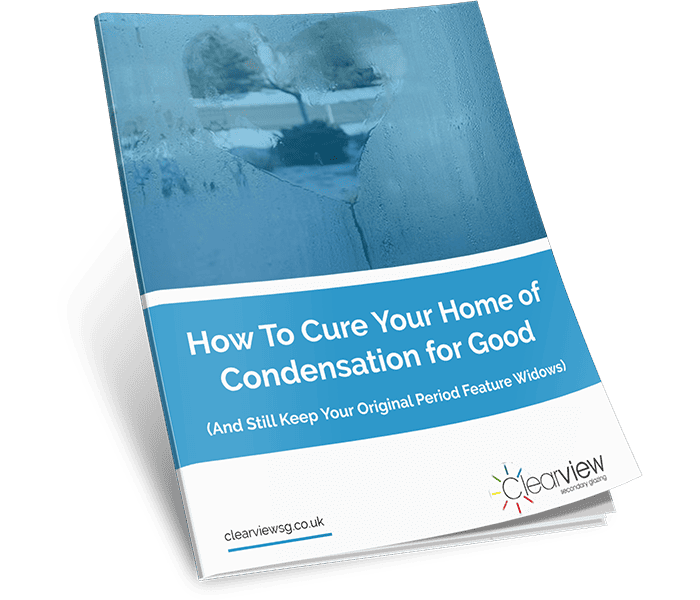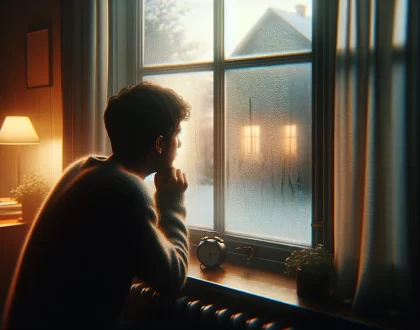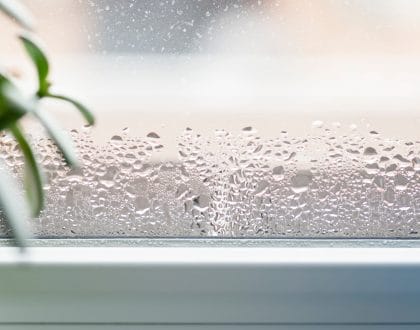Tackling Condensation Guide

Help eliminate condensation in your home with secondary glazing.
Thinking about secondary glazing to get rid of condensation in your property? You’ve made a good decision.
Fitting Clearview secondary glazing in your property eliminates condensation in the majority of cases. Occasionally there are conditions where it can’t significantly reduce condensation, but in most cases installing secondary glazing really helps. Secondary glazing provides an effective internal seal, which allows for balanced ventilation in the space between the primary glass and the secondary glazed unit. This seal prevents the inner glass becoming too cold, and so stops condensation forming. Clearview secondary glazing is a simple to fit, cost-effective solution – whether you fit yourself or have a Clearview approved installer fit for you.
What Is Condensation?
Air is full of moisture. The warmer the air, the more moisture it can support. When air temperature drops (as it does in autumn, for instance) the air can’t contain all the moisture and so tiny drops of water appear. You see it when you breathe on a cold day, or when the bathroom mirror mists over when you shower. That’s condensation. Condensation appears in places where there isn’t much air movement – in or behind wardrobes and cupboards. It often forms on north-facing walls, or near windows.
What Causes Condensation?
Each of us adds nearly 60ml of water to the atmosphere an hour as we breathe. Heating appliances, like paraffin stoves, contribute a staggering volume of 10 pints of water for every 8 pints of fuel used, and the consumption of 1 cubic foot of gas discharges 1 cubic foot of water into the air. Cooking, and washing and drying laundry indoors also contribute to this reservoir of water. The condition of primary windows can be a contributory factor. If they are ill fitting, they can allow too much cold air to circulate between the glasses, causing condensation. Glazing putty in poor condition allows rain underneath, getting drawn inside the windows by capillary action, increasing the humidity of the air within the cavity. A building construction fault can create a condensation problem. Masonry in poor condition, or the primary windows with rotten frame sections.
Clearview technicians have researched the problem of condensation, and acted on advice from the Insulation Glazing Association and the Ministry of Public Building and Works. Sometimes, condensation is attributed to fitting secondary glazing. However, building experts agree that’s seldom the cause, and secondary glazing cannot cause condensation where it didn’t previously exist. It’s clear that condensation is a complex problem. And although, in the vast majority of cases, installing secondary glazing eliminates or reduces it, there are occasional cases where it’s impossible to identify the source of excess humidity, or effect a cure, our contract draws attention to this. In many properties, other causes of moisture are evident, on walls for example, where visible dampness climbs upwards from floor level indicating rain penetration, or rising damp because of a faulty damp proof course.
Many older properties don’t have damp courses. As well as the primary condensation causes, there can be an associated secondary cause; in that as the initial moisture evaporates the resulting salt crystals become concentrated on or near walls. Most of these salts eventually appear as efflorescence causing no further trouble, but some (notably chlorides and nitrates) remain, and being hygroscopic, absorb moisture from the air. Outside, vegetation, climbing plants and faulty gutters can be sources of moisture. The condition of brickwork pointing and sills, and the way window and door frames are fitted should be checked, as they can affect the success of secondary glazing from a condensation point of view. Despite adequate heat, without sufficient ventilation a small amount of internal moisture can become excess humidity. The modern tendency to seal our homes against bad weather also prevents buildings from breathing. By concentrating on preventing moisture from coming in, we’ve also prevented interior moisture from escaping. Ideally, a building’s humidity, heating and ventilation should be balanced. The balance will vary seasonally, but a bit of time experimenting with finding the correct levels is often rewarded with a good measure of success.
4 steps to reduce humidity in your home
1 Control the source of humidity.
Vent gas burners, clothes dryers etc. to the outside. Fit extractor fans, particularly in kitchen or bathroom. Make sure you have adequate vents and air bricks throughout the house.
2 Provide ventilation.
Outside air is usually dryer, so dilutes the humidity of inside air. In older houses, this often occurs automatically because of constant infiltration of outside air through ill-fitting windows and doors.
3 Heating.
Provide dry heat to counterbalance most of the moisture produced by modern living.
4 Air passage.
Ensure existing air bricks are unobstructed.
5 ways of controlling condensation in your house
1 Fit secondary glazing
2 Increase the running time of kitchen or other ventilation fans.
3 Encourage moisture to escape by opening fireplace dampers or vents.
4 Open doors and windows for a few minutes each day to air your house.
5 Air kitchen, laundry and bathrooms during or just following use, closing any doors which allow steam to permeate the rest of the house.
Temporary condensation
There are two frequent causes of temporary condensation, which disappear after a month or so of heating. The first affects new buildings. Timber, plaster and other building materials contain a lot of water. As the heating is turned on, this moisture gradually flows into the surrounding air, before disappearing. The second cause, in a milder form, occurs in autumn. As the central heating is turned on, a small amount of moisture the building has absorbed during the summer will dry out.
Got a condensation query? Contact Clearview at [email protected]

Discover How To Cure Your Home of Condensation for Good
Yes, you did read that correctly. Unlike the common cold, there is a cure for condensation. A permanent one. In this free eGuide – written by specialists – you will discover how to get rid of condensation – for good and enjoy a warm, dry home again.
Simply enter your name and email below and we will send a free copy straight to your inbox.
Recommended Posts

How can I stop condensation?
06/02/2024

Why Are My Windows Wet Every Morning?
07/01/2021

 10 Year Guarantee
10 Year Guarantee 5 Star Customer Reviews
5 Star Customer Reviews
